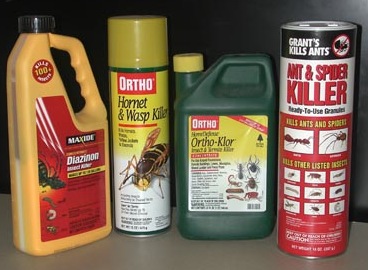|
|














Pesticides
by Nick Gromicko and Rob
London

Pesticides are poisons designed to kill a variety of plants
and animals, such as insects (insecticides), weeds (herbicides),
and mold or fungus (fungicides). They are each composed of an
inert carrier and a pest-specific active ingredient, both of
which are toxic to humans and pets.
Human Exposure
Pesticides may enter the body in one of the following three
ways, which are ordered from least to most dangerous:
- absorbed through the skin. People can get pesticide on their skin because it is likely to splash or mist while mixing, loading or applying the chemicals. Skin contact may also occur while touching protective clothing, a piece of equipment, or any other surface that was exposed to pesticides;
- swallowed. Numerous reports exist of people accidentally drinking or eating a pesticide that had been placed in an unlabelled container, or by children whose access was not adequately child-proofed. Toxic substances can also be ingested when eating or smoking near those who have handled the chemicals; and
- inhaled. Powders, airborne droplets and vapors can easily be inhaled. Low-pressure applications present a relatively limited hazard because most of the droplets are too large and heavy to remain in the air. High-pressure applications, however, are particularly dangerous because the droplets are small enough that they can be carried by winds for considerable distances. Pesticides with a high inhalation hazard should have a label that instructs the user to use a respirator.
Health Effects and Symptoms of Pesticide
Exposure
The health effects of pesticides are specific to their
ingredients. Organophosphates and carbamates, for instance,
affect the nervous system, while others may irritate the
skin and eyes, influence the body’s
hormone or endocrine system, and even cause cancer. Symptoms
of pesticide exposure may appear immediately and disappear soon
after exposure has ceased, or they may take a long time
-- even years -- to develop. Specific symptoms include,
but are not limited to, the following.
Acute symptoms include:
- mild poisoning: irritation of the nose, throat, eyes or skin, headache, dizziness, loss of appetite, thirst, nausea, diarrhea, sweating, weakness or fatigue, restlessness, nervousness, changes in mood, and/or insomnia;
- moderate poisoning: vomiting, excessive salivation, coughing, constriction of the throat and chest, abdominal cramps, blurred vision, rapid pulse, excessive perspiration, profound weakness, trembling, muscular incoordination, and/or mental confusion;
- severe poisoning: inability to breathe, small or pinpoint pupils, chemical burns, uncontrollable muscular twitching, unconsciousness, and/or death.
Long-term health effects include:
- cancers (lung, brain, testicular, lymphoma, leukemia);
- spontaneous abortions and stillbirths;
- genetic damage;
- infertility, including lowered sperm count;
- liver and pancreatic damage;
- neuropathy; and
- disturbances to immune systems (including minor ones, such as asthma and allergies).
Drift
Only a small percentage of insecticides and herbicides
actually reach their intended destinations. The bulk of the
chemicals find their way to other places, such as the air, water,
food sources, and non-targeted
insect/animal species. People and pets track pesticide
residue into the house where it may settle on laundry, furniture,
toys, and virtually anyplace else. Most runs off into water or
dissipates in the air, where it may endanger the
environment. This incidential or unintended travel is known
as "drift."
Fumigant pesticides used outdoors have the potential to
travel many miles from their intended targets, drifting through
the air into schools, homes, parks and playgrounds. Pesticide
drift has resulted in cases of mass hospitalizations, such as in
2007 when 121 workers in Nevada were rushed to the hospital after
fumigant pesticide traveled ¼-mile from its
intended target. Home gardens usually require significantly less
pesticide than large-scale agriculture, although the latter is
usually held to safety standards that gardeners are more likely
to ignore. 

Warning Labels on Pesticides
Manufacturers of pesticides create warning labels for their products by considering how harmful the chemical would be through each route of entry into the body. The signal word that applies to the most dangerous route of entry is the one that goes on the label. Any one of the following signal words should appear on pesticide warning labels:
- CAUTION: slightly hazardous by any of the routes of entry.
- WARNING: moderately hazardous by at least one route of entry.
- DANGER: highly hazardous by at least one route of entry. The word "DANGER" alone means that the pesticide’s greatest hazard is that it can severely irritate your skin or your eyes, or both. If the pesticide has the word "DANGER" plus a skull-and-crossbones symbol, it means that the pesticide is highly toxic through one or more routes of entry. Funginex®, for instance, has the signal word "DANGER" on its label because it is a severe eye irritant. If it were highly toxic through oral, dermal or inhalation exposure, it would have the word "POISON" and the skull-and-crossbones symbol.
Labels should also contain a “hazard to
humans†section and a “personal
protective equipment†section, in which users can
learn which kinds of exposures the signal word for that
particular pesticide refers to.
Safety Tips:
- Limit termite infestation -- and the necessity for pesticide use -- by building with steel, concrete or brick. Borate-treated lumber will repel carpenter ants and termites.
- Plant disease-resistant plants around the home.
- Always keep these chemicals away from children.
- If you must handle pesticides, wear gloves and long sleeves, and avoid breathing the vapors.
- Carefully follow directions with regard to concentration, protective gear, and restricting access to areas that have been treated.
- Always ventilate the area well after use.
- Mix or dilute chemicals outdoors, if possible.
- Dispose of unwanted pesticides safely, and store partially-used containers outside the living space.
- Leather items contaminated with pesticides should be discarded. According to Montana State University, when leather watch bands, boots and gloves are worn and become damp, the person will again be exposed to the pesticide.
- Address any additional concerns with your InterNACHI inspector during your next scheduled inspection.
TRIPLE M LLC
Pesticides